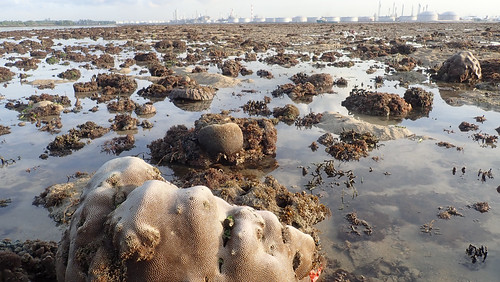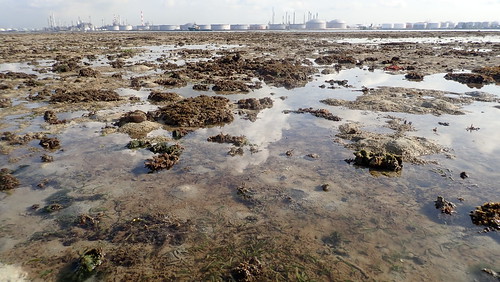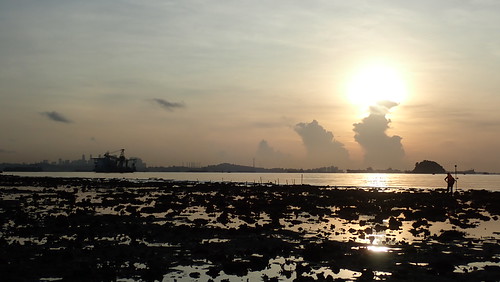I was worried to see a few corals that were bleaching, but most of the corals seemed alright. The seagrass situation seems to be slowly improving. The rest of the team saw lots of interesting animals including a seahorse!
Among the amazing colourful animals here are large Magnificent sea anemones. These animals clone themselves and thus often found in clusters of individuals with similarly coloured body columns. There were also many Giant carpet anemones. Some had clown anemonefishes, although they were very shy. I saw one Merten's carpet anemone.
The Burrowing giant clam is still there. But none of us saw any other Giant clams.
It was nice to see some small clumps of Xenia soft corals. These animals pulse in the water!
There were also many large Diadema sea urchins, and I saw common nudibranchs.
I sense I saw less variety of hard corals and fewer colonies of each kind compared to our last survey in May 2018. Today, although most corals were alright, I saw a few that were bleaching. This included common ones like Boulder pore corals, Flowery disk corals (all were pale, a few were bleaching), Anemone corals (most were alright, a few were bleaching), Sandpaper corals (most were alright, a one had very pale edges).
Uncommon corals were also bleaching: Anchor corals (most were alright, some had small portions that were bleaching), one Boulder horn coral was bleaching, I saw one Lettuce coral with white edges, one large Trumpet coral colony was bleaching, the rest were not. Some of the Brain corals looked very pale. I did see many corals that were NOT bleaching: Cauliflower corals, mushroom corals and more.
Most of the leathery soft corals I saw were alright, although some had pale patches.
I saw many Asparagus flowery soft corals that were pale and oddly coloured. I saw some pale Sea mat zoanthids and Button zoanthids.
The seagrass situation seems similar to what we saw in May 2018, i.e., slowly improving. Although heavily covered with epiphytes, there was good cover of Spoon seagrasses on many of the pools in the middle of the reef flat.
There were many clumps of Tape seagrass with longish leaf blades. Although also many clumps with short cropped leaves. I saw many small clusters of Serrated ribbon seagrass that looked fresh and green.
There used to be lush seagrass meadows on Terumbu Semakau. Here's what the seagrass meadows looked like when we visited in June 2010. Let's hope the seagrasses will return soon!
Today, there was a huge vessel in the area.
It is doing soil investigations (according to Port Marine Notice 039 of 2019 dated 3 May 2019). Seems the works will be from 05 May 2019 to 30 Sep 2019.
Today, we didn't come across any nets or traps.
Fate of Terumbu Semakau?
Terumbu Semakau is one of the existing natural shores that may be impacted by the landuse plan by the Ministry of National Development released in Jan 2013 in response to the Populations White Paper with a 6.9 million population target. The dotted margined blue areas are "Possible Future Reclamation".


The Singapore Blue Plan 2018
Pulau Semakau and nearby islands and submerged reefs have been recommended by the Singapore Blue Plan 2018 for Immediate Conservation Priority.
The Blue Plan recommends the intertidal and subtidal marine areas of Pulau Semakau and adjacent Pulau Hantu, and Pulau Jong to be designated Marine Reserve.
The Blue Plan highlights that Pulau Semakau and its associated patch reefs comprise many ecosystems: coral reefs, mangrove areas, intertidal sandflats, seagrass meadows, and coral reefs. The subtidal area of Pulau Jong is larger than the terrestrial area. Pulau Hantu is a popular dive site has seen increasing interest in the past decade due to biodiversity awareness. If protection is accorded to these three islands, zonation plans for use can be implemented to manage tourism and human impacts.
DOWNLOAD the Plan, SUPPORT the Plan! More on the Singapore Blue Plan 2018 site.
Photos by others on this trip
Shawne Goh
Liz Lim
Juria Toramae
Kelvin Yong















